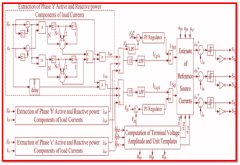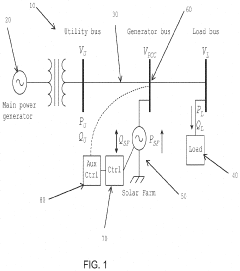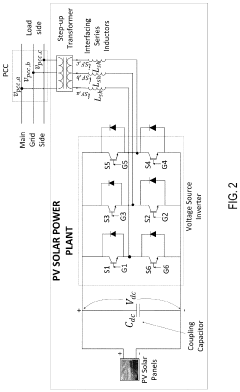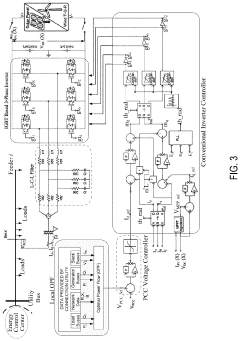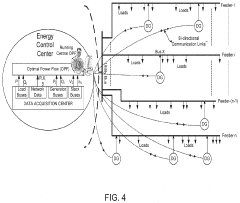The Future of Distributed Energy with Solar Inverters
JUL 17, 20259 MIN READ
Generate Your Research Report Instantly with AI Agent
Patsnap Eureka helps you evaluate technical feasibility & market potential.
Solar Inverter Evolution and Objectives
Solar inverters have undergone significant evolution since their inception, transforming from simple grid-tied devices to sophisticated power conversion and management systems. The journey began in the 1990s with rudimentary string inverters, which converted DC power from solar panels to AC power for grid use. These early models were characterized by their simplicity and limited functionality, primarily focused on basic power conversion.
As solar technology advanced, so did inverter capabilities. The early 2000s saw the introduction of more efficient and reliable inverters, incorporating features like maximum power point tracking (MPPT) to optimize energy harvest. This period also marked the emergence of micro-inverters, which revolutionized system design by allowing for panel-level power conversion and monitoring.
The next major leap came with the advent of smart inverters in the 2010s. These devices integrated communication capabilities, enabling remote monitoring and control. Smart inverters also introduced grid support functions, such as voltage regulation and reactive power control, enhancing grid stability and paving the way for higher penetration of distributed solar energy.
Recent years have witnessed the rise of hybrid inverters, combining solar power conversion with battery storage management. This integration is crucial for the development of more resilient and flexible energy systems, allowing for greater energy independence and grid support during peak demand or outages.
Looking ahead, the objectives for solar inverter technology are multifaceted. A primary goal is to further increase efficiency, pushing conversion rates beyond 99% to minimize energy losses. Enhancing reliability and longevity is another key focus, with aims to extend operational lifespans to 25 years or more, matching the durability of solar panels.
Integration of advanced power electronics, such as wide-bandgap semiconductors like silicon carbide (SiC) and gallium nitride (GaN), is a critical objective. These materials promise higher switching frequencies, reduced losses, and improved thermal performance, enabling more compact and efficient inverter designs.
Another significant aim is to expand grid support capabilities. Future inverters are expected to play a more active role in grid stabilization, offering advanced features like fast frequency response, synthetic inertia, and seamless islanding capabilities. This evolution will be crucial in facilitating the transition to a predominantly renewable energy grid.
Lastly, there's a strong focus on enhancing connectivity and intelligence. The next generation of inverters will likely incorporate AI and machine learning algorithms for predictive maintenance, optimized energy management, and adaptive grid interaction. This smart functionality will be essential in creating more resilient, efficient, and responsive distributed energy systems.
As solar technology advanced, so did inverter capabilities. The early 2000s saw the introduction of more efficient and reliable inverters, incorporating features like maximum power point tracking (MPPT) to optimize energy harvest. This period also marked the emergence of micro-inverters, which revolutionized system design by allowing for panel-level power conversion and monitoring.
The next major leap came with the advent of smart inverters in the 2010s. These devices integrated communication capabilities, enabling remote monitoring and control. Smart inverters also introduced grid support functions, such as voltage regulation and reactive power control, enhancing grid stability and paving the way for higher penetration of distributed solar energy.
Recent years have witnessed the rise of hybrid inverters, combining solar power conversion with battery storage management. This integration is crucial for the development of more resilient and flexible energy systems, allowing for greater energy independence and grid support during peak demand or outages.
Looking ahead, the objectives for solar inverter technology are multifaceted. A primary goal is to further increase efficiency, pushing conversion rates beyond 99% to minimize energy losses. Enhancing reliability and longevity is another key focus, with aims to extend operational lifespans to 25 years or more, matching the durability of solar panels.
Integration of advanced power electronics, such as wide-bandgap semiconductors like silicon carbide (SiC) and gallium nitride (GaN), is a critical objective. These materials promise higher switching frequencies, reduced losses, and improved thermal performance, enabling more compact and efficient inverter designs.
Another significant aim is to expand grid support capabilities. Future inverters are expected to play a more active role in grid stabilization, offering advanced features like fast frequency response, synthetic inertia, and seamless islanding capabilities. This evolution will be crucial in facilitating the transition to a predominantly renewable energy grid.
Lastly, there's a strong focus on enhancing connectivity and intelligence. The next generation of inverters will likely incorporate AI and machine learning algorithms for predictive maintenance, optimized energy management, and adaptive grid interaction. This smart functionality will be essential in creating more resilient, efficient, and responsive distributed energy systems.
Distributed Energy Market Analysis
The distributed energy market, particularly in relation to solar inverters, is experiencing significant growth and transformation. This market is driven by several key factors, including the increasing adoption of renewable energy sources, the need for grid modernization, and the growing demand for energy independence and resilience.
The global distributed energy market is projected to expand rapidly in the coming years, with solar power playing a crucial role. Solar inverters, which convert the direct current (DC) output of solar panels into alternating current (AC) for use in homes and businesses, are a critical component of this market. The solar inverter market alone is expected to grow substantially, driven by the increasing installation of solar photovoltaic (PV) systems worldwide.
One of the primary drivers of this market growth is the declining cost of solar technology. As solar panels and inverters become more affordable, the adoption of distributed solar energy systems has accelerated across residential, commercial, and industrial sectors. This trend is particularly evident in regions with high electricity costs or unreliable grid infrastructure.
Government policies and incentives have also played a significant role in shaping the distributed energy market. Many countries have implemented feed-in tariffs, tax credits, and other financial incentives to encourage the adoption of solar and other renewable energy technologies. These policies have been instrumental in driving market growth and technological innovation in the solar inverter industry.
The integration of smart grid technologies and the Internet of Things (IoT) is another key trend influencing the distributed energy market. Advanced solar inverters now offer features such as remote monitoring, predictive maintenance, and grid support functions, enhancing their value proposition for both consumers and utilities. This trend towards smarter, more connected distributed energy systems is expected to continue, driving further market expansion.
Energy storage systems, particularly battery technologies, are increasingly being paired with solar inverters to provide greater flexibility and reliability in distributed energy systems. This combination allows for better management of intermittent solar generation and enables consumers to maximize their self-consumption of solar energy.
The market for distributed energy and solar inverters is also being shaped by evolving grid regulations and standards. As the penetration of distributed energy resources increases, utilities and regulators are developing new frameworks to ensure grid stability and reliability. These regulations often require advanced inverter capabilities, such as voltage and frequency support, which is driving innovation in inverter design and functionality.
The global distributed energy market is projected to expand rapidly in the coming years, with solar power playing a crucial role. Solar inverters, which convert the direct current (DC) output of solar panels into alternating current (AC) for use in homes and businesses, are a critical component of this market. The solar inverter market alone is expected to grow substantially, driven by the increasing installation of solar photovoltaic (PV) systems worldwide.
One of the primary drivers of this market growth is the declining cost of solar technology. As solar panels and inverters become more affordable, the adoption of distributed solar energy systems has accelerated across residential, commercial, and industrial sectors. This trend is particularly evident in regions with high electricity costs or unreliable grid infrastructure.
Government policies and incentives have also played a significant role in shaping the distributed energy market. Many countries have implemented feed-in tariffs, tax credits, and other financial incentives to encourage the adoption of solar and other renewable energy technologies. These policies have been instrumental in driving market growth and technological innovation in the solar inverter industry.
The integration of smart grid technologies and the Internet of Things (IoT) is another key trend influencing the distributed energy market. Advanced solar inverters now offer features such as remote monitoring, predictive maintenance, and grid support functions, enhancing their value proposition for both consumers and utilities. This trend towards smarter, more connected distributed energy systems is expected to continue, driving further market expansion.
Energy storage systems, particularly battery technologies, are increasingly being paired with solar inverters to provide greater flexibility and reliability in distributed energy systems. This combination allows for better management of intermittent solar generation and enables consumers to maximize their self-consumption of solar energy.
The market for distributed energy and solar inverters is also being shaped by evolving grid regulations and standards. As the penetration of distributed energy resources increases, utilities and regulators are developing new frameworks to ensure grid stability and reliability. These regulations often require advanced inverter capabilities, such as voltage and frequency support, which is driving innovation in inverter design and functionality.
Solar Inverter Technology Landscape
Solar inverter technology has undergone significant advancements in recent years, shaping the landscape of distributed energy systems. These devices, which convert direct current (DC) from solar panels into alternating current (AC) for use in homes and the grid, have become increasingly sophisticated and efficient.
The current solar inverter market is dominated by string inverters and microinverters, each with distinct advantages. String inverters, traditionally used in larger installations, have improved in efficiency and now offer features like maximum power point tracking (MPPT) for optimized energy harvest. Microinverters, attached to individual solar panels, have gained popularity in residential settings due to their ability to maximize performance of each panel independently.
A key trend in the solar inverter landscape is the integration of smart features and connectivity. Modern inverters now incorporate advanced monitoring capabilities, allowing real-time performance tracking and remote diagnostics. This connectivity enables better system management and facilitates integration with smart home systems and energy management platforms.
Energy storage integration is another significant development in the solar inverter space. Hybrid inverters, capable of managing both solar power and battery storage, are becoming increasingly prevalent. These systems allow for greater energy independence and provide backup power during grid outages, enhancing the overall resilience of solar installations.
The push for higher efficiency has led to the development of new inverter topologies and materials. Wide-bandgap semiconductors, such as silicon carbide (SiC) and gallium nitride (GaN), are being incorporated into inverter designs, offering improved power density and reduced energy losses. These advancements contribute to smaller, more efficient, and more reliable inverter systems.
Grid support functionality is an emerging focus in inverter technology. Modern inverters are designed to provide grid services such as voltage regulation, frequency support, and reactive power control. This capability allows solar systems to play a more active role in maintaining grid stability, particularly in areas with high renewable energy penetration.
As the solar industry continues to grow, inverter manufacturers are also focusing on scalability and modularity. This approach allows for easier system expansion and maintenance, catering to the evolving needs of both residential and commercial solar installations. The trend towards plug-and-play solutions aims to simplify installation processes and reduce overall system costs.
The current solar inverter market is dominated by string inverters and microinverters, each with distinct advantages. String inverters, traditionally used in larger installations, have improved in efficiency and now offer features like maximum power point tracking (MPPT) for optimized energy harvest. Microinverters, attached to individual solar panels, have gained popularity in residential settings due to their ability to maximize performance of each panel independently.
A key trend in the solar inverter landscape is the integration of smart features and connectivity. Modern inverters now incorporate advanced monitoring capabilities, allowing real-time performance tracking and remote diagnostics. This connectivity enables better system management and facilitates integration with smart home systems and energy management platforms.
Energy storage integration is another significant development in the solar inverter space. Hybrid inverters, capable of managing both solar power and battery storage, are becoming increasingly prevalent. These systems allow for greater energy independence and provide backup power during grid outages, enhancing the overall resilience of solar installations.
The push for higher efficiency has led to the development of new inverter topologies and materials. Wide-bandgap semiconductors, such as silicon carbide (SiC) and gallium nitride (GaN), are being incorporated into inverter designs, offering improved power density and reduced energy losses. These advancements contribute to smaller, more efficient, and more reliable inverter systems.
Grid support functionality is an emerging focus in inverter technology. Modern inverters are designed to provide grid services such as voltage regulation, frequency support, and reactive power control. This capability allows solar systems to play a more active role in maintaining grid stability, particularly in areas with high renewable energy penetration.
As the solar industry continues to grow, inverter manufacturers are also focusing on scalability and modularity. This approach allows for easier system expansion and maintenance, catering to the evolving needs of both residential and commercial solar installations. The trend towards plug-and-play solutions aims to simplify installation processes and reduce overall system costs.
Current Solar Inverter Solutions
01 Grid-tied solar inverter systems
Grid-tied solar inverter systems are designed to connect photovoltaic arrays to the utility grid. These systems typically include features for maximum power point tracking, DC-to-AC conversion, and grid synchronization. They often incorporate safety mechanisms such as anti-islanding protection and may support bidirectional power flow for energy storage integration.- Grid-tied solar inverter systems: Grid-tied solar inverter systems are designed to connect solar panels to the utility grid. These systems convert DC power from solar panels to AC power compatible with the grid, allowing for bidirectional power flow. They often include features like maximum power point tracking (MPPT) and anti-islanding protection for safety and efficiency.
- Microinverter technology: Microinverters are small inverters attached to individual solar panels or small groups of panels. They convert DC to AC at the panel level, offering advantages such as improved efficiency, easier system scalability, and better performance in partially shaded conditions. Microinverters also provide panel-level monitoring and can enhance system reliability.
- Power optimization and management in solar inverters: Advanced solar inverters incorporate power optimization and management features to maximize energy harvest and system efficiency. These may include sophisticated MPPT algorithms, reactive power control, and smart grid integration capabilities. Some inverters also offer energy storage integration and load management functionalities for enhanced system performance.
- Thermal management and reliability enhancements: Solar inverters employ various thermal management techniques and reliability enhancements to ensure long-term performance and durability. These may include advanced cooling systems, high-quality components, and protective features against environmental stresses. Some designs focus on reducing component count and improving fault tolerance to increase overall system reliability.
- Multi-level and high-frequency inverter topologies: Advanced inverter topologies, such as multi-level and high-frequency designs, are used to improve efficiency, reduce harmonics, and decrease the size and weight of solar inverters. These topologies can offer benefits like lower switching losses, improved power quality, and reduced electromagnetic interference. Some designs also incorporate wide-bandgap semiconductors for enhanced performance.
02 Microinverter technology
Microinverters are small inverters attached to individual solar panels or small groups of panels. They convert DC to AC at the panel level, offering advantages such as improved system efficiency, easier installation, and enhanced monitoring capabilities. Microinverters can also mitigate the effects of partial shading and panel mismatch.Expand Specific Solutions03 Power optimization and management
Solar inverters incorporate various power optimization and management techniques to enhance overall system performance. These may include advanced maximum power point tracking algorithms, reactive power control, and intelligent power management strategies. Such features aim to maximize energy yield, improve grid stability, and optimize system efficiency under varying environmental conditions.Expand Specific Solutions04 Thermal management and reliability
Effective thermal management is crucial for solar inverter reliability and longevity. Inverter designs may incorporate advanced cooling systems, temperature monitoring, and thermal protection mechanisms. Additionally, inverters may feature modular designs, redundant components, or fault-tolerant architectures to enhance overall system reliability and minimize downtime.Expand Specific Solutions05 Smart grid integration and communication
Modern solar inverters are designed with smart grid integration capabilities, including advanced communication protocols and monitoring systems. These features enable real-time data exchange with grid operators, remote monitoring and control, and integration with energy management systems. Smart inverters can also provide grid support functions such as voltage regulation and frequency response.Expand Specific Solutions
Key Solar Inverter Manufacturers
The distributed energy market with solar inverters is in a growth phase, characterized by increasing adoption of renewable energy solutions and smart grid technologies. The market size is expanding rapidly, driven by global efforts to reduce carbon emissions and enhance energy efficiency. Technologically, the field is advancing with innovations in power electronics, energy storage integration, and grid management. Key players like Enphase Energy, SolarEdge Technologies, and Huawei Technologies are leading the innovation curve, developing advanced microinverter and optimizer technologies. Established companies such as Mitsubishi Electric and Sharp Corp. are also making significant contributions, leveraging their extensive experience in power systems. The competitive landscape is diverse, with both specialized solar technology firms and large conglomerates vying for market share.
Enphase Energy, Inc.
Technical Solution: Enphase Energy is pioneering microinverter technology for solar systems. Their IQ8 microinverters enable a grid-forming microgrid, allowing solar energy production even during power outages[1]. The company's Ensemble energy management technology integrates solar, storage, and smart grid services, enabling a truly distributed energy future[2]. Enphase's microinverters attach to individual solar panels, converting DC to AC at the panel level, which increases system efficiency and reliability[3]. Their latest innovations include rapid shutdown capabilities and advanced grid support functions, enhancing safety and grid stability[4].
Strengths: High efficiency, panel-level optimization, and enhanced reliability. Weaknesses: Higher initial cost compared to string inverters, and potential for more points of failure due to multiple components.
SolarEdge Technologies, Inc.
Technical Solution: SolarEdge is advancing power optimizers and inverter technology for solar systems. Their HD-Wave technology significantly reduces the size and weight of inverters while increasing efficiency to 99%[5]. SolarEdge's power optimizers enable module-level power electronics (MLPE), maximizing energy production from each panel[6]. The company is also integrating EV charging capabilities into their inverters, facilitating the convergence of solar and electric vehicle technologies[7]. SolarEdge's monitoring platform provides real-time performance data and remote troubleshooting capabilities, enhancing system management and maintenance[8].
Strengths: High efficiency, flexible system design, and integrated EV charging. Weaknesses: Reliance on proprietary components and potentially higher system costs.
Innovative Solar Inverter Patents
Generation of reference current using single-phase source-load system based control algorithm for dstatcom
PatentPendingIN202141030198A
Innovation
- A new control algorithm for DSTATCOM is developed, utilizing differential equations to separate active and reactive current elements from polluted load currents, incorporating a hybrid-STATCOM with a TCLC part for reactive power compensation and an active inverter part for improving performance under varying conditions, ensuring minimal impact on DC components and resistance to noise and frequency variations.
Use of distributed generator (DG) inverters as statcoms for decreasing line losses
PatentActiveUS20200150707A1
Innovation
- Implementing a system-wide coordinated control of inverter-based distributed generators (DGs) operating as Static Synchronous Compensators (STATCOMs) to dynamically regulate voltage levels, minimizing line losses by exchanging controlled reactive power using available inverter capacity after real power generation or absorption.
Grid Integration Challenges
The integration of solar inverters into the existing power grid presents significant challenges that must be addressed to ensure the successful implementation of distributed energy systems. One of the primary concerns is the potential for voltage fluctuations and power quality issues. As solar energy production varies throughout the day and with changing weather conditions, the power output from solar inverters can fluctuate rapidly, leading to voltage instability in the grid. This can cause problems for sensitive electronic equipment and may require additional voltage regulation mechanisms.
Another critical challenge is the need for advanced control systems and communication protocols. Traditional power grids were designed for one-way power flow from centralized generation sources to consumers. However, with the introduction of distributed solar energy, the grid must now accommodate bi-directional power flow. This requires sophisticated control systems that can manage the complex interactions between multiple solar inverters and the grid, ensuring stable operation and efficient energy distribution.
Grid stability and reliability are also major concerns when integrating large numbers of solar inverters. The intermittent nature of solar power can lead to sudden changes in power supply, which may cause frequency deviations and potentially trigger grid protection mechanisms. To mitigate these risks, grid operators must implement advanced forecasting tools and energy storage solutions to balance supply and demand effectively.
Furthermore, the existing grid infrastructure may require significant upgrades to handle the increased penetration of solar energy. This includes reinforcing transmission and distribution networks, upgrading substations, and implementing smart grid technologies. The cost and complexity of these upgrades pose a substantial challenge for utilities and grid operators.
Cybersecurity is an emerging concern in the context of grid integration. As solar inverters become more interconnected and reliant on digital communication, they become potential targets for cyberattacks. Ensuring the security of these systems is crucial to prevent unauthorized access and potential disruptions to the power supply.
Lastly, regulatory and policy frameworks must evolve to keep pace with the changing energy landscape. Current regulations may not adequately address the unique challenges posed by distributed solar energy systems, creating barriers to their widespread adoption and integration. Developing appropriate standards, interconnection policies, and market mechanisms is essential to facilitate the seamless integration of solar inverters into the grid while maintaining system reliability and fairness for all stakeholders.
Another critical challenge is the need for advanced control systems and communication protocols. Traditional power grids were designed for one-way power flow from centralized generation sources to consumers. However, with the introduction of distributed solar energy, the grid must now accommodate bi-directional power flow. This requires sophisticated control systems that can manage the complex interactions between multiple solar inverters and the grid, ensuring stable operation and efficient energy distribution.
Grid stability and reliability are also major concerns when integrating large numbers of solar inverters. The intermittent nature of solar power can lead to sudden changes in power supply, which may cause frequency deviations and potentially trigger grid protection mechanisms. To mitigate these risks, grid operators must implement advanced forecasting tools and energy storage solutions to balance supply and demand effectively.
Furthermore, the existing grid infrastructure may require significant upgrades to handle the increased penetration of solar energy. This includes reinforcing transmission and distribution networks, upgrading substations, and implementing smart grid technologies. The cost and complexity of these upgrades pose a substantial challenge for utilities and grid operators.
Cybersecurity is an emerging concern in the context of grid integration. As solar inverters become more interconnected and reliant on digital communication, they become potential targets for cyberattacks. Ensuring the security of these systems is crucial to prevent unauthorized access and potential disruptions to the power supply.
Lastly, regulatory and policy frameworks must evolve to keep pace with the changing energy landscape. Current regulations may not adequately address the unique challenges posed by distributed solar energy systems, creating barriers to their widespread adoption and integration. Developing appropriate standards, interconnection policies, and market mechanisms is essential to facilitate the seamless integration of solar inverters into the grid while maintaining system reliability and fairness for all stakeholders.
Energy Storage Synergies
The integration of energy storage systems with solar inverters represents a significant advancement in distributed energy solutions. This synergy enhances the overall efficiency and reliability of solar power systems, addressing key challenges such as intermittency and grid stability. Modern solar inverters are increasingly designed with built-in capabilities to interface seamlessly with battery storage units, allowing for more effective energy management and utilization.
One of the primary benefits of this integration is the ability to store excess solar energy generated during peak production hours for use during periods of low or no solar generation. This load-shifting capability not only maximizes self-consumption of solar energy but also reduces reliance on the grid during high-demand periods. Advanced inverters with energy storage integration can provide sophisticated power management features, including peak shaving, demand response, and grid support functions.
The combination of solar inverters and energy storage also plays a crucial role in enhancing grid resilience. During power outages, these systems can operate in island mode, providing backup power to critical loads. This feature is particularly valuable in areas prone to natural disasters or with unreliable grid infrastructure. Furthermore, the integration allows for more precise control over power quality, helping to stabilize voltage and frequency at the point of connection.
From a technical standpoint, the integration of energy storage with solar inverters involves complex power electronics and control algorithms. Modern inverters must be capable of bidirectional power flow, managing both the charging and discharging of batteries while simultaneously handling solar power generation. This requires advanced monitoring and communication systems to optimize energy flow based on factors such as solar irradiance, battery state of charge, and grid conditions.
Looking ahead, the synergy between solar inverters and energy storage is expected to drive innovation in smart home and building energy management systems. These integrated solutions will likely incorporate artificial intelligence and machine learning algorithms to predict energy consumption patterns, optimize storage utilization, and participate in emerging energy markets such as virtual power plants and peer-to-peer energy trading platforms.
As the cost of both solar panels and battery storage continues to decline, the adoption of integrated solar-plus-storage systems is projected to accelerate. This trend will contribute significantly to the decentralization of energy production and consumption, empowering consumers to take greater control over their energy usage while supporting the broader transition to a more sustainable and resilient energy infrastructure.
One of the primary benefits of this integration is the ability to store excess solar energy generated during peak production hours for use during periods of low or no solar generation. This load-shifting capability not only maximizes self-consumption of solar energy but also reduces reliance on the grid during high-demand periods. Advanced inverters with energy storage integration can provide sophisticated power management features, including peak shaving, demand response, and grid support functions.
The combination of solar inverters and energy storage also plays a crucial role in enhancing grid resilience. During power outages, these systems can operate in island mode, providing backup power to critical loads. This feature is particularly valuable in areas prone to natural disasters or with unreliable grid infrastructure. Furthermore, the integration allows for more precise control over power quality, helping to stabilize voltage and frequency at the point of connection.
From a technical standpoint, the integration of energy storage with solar inverters involves complex power electronics and control algorithms. Modern inverters must be capable of bidirectional power flow, managing both the charging and discharging of batteries while simultaneously handling solar power generation. This requires advanced monitoring and communication systems to optimize energy flow based on factors such as solar irradiance, battery state of charge, and grid conditions.
Looking ahead, the synergy between solar inverters and energy storage is expected to drive innovation in smart home and building energy management systems. These integrated solutions will likely incorporate artificial intelligence and machine learning algorithms to predict energy consumption patterns, optimize storage utilization, and participate in emerging energy markets such as virtual power plants and peer-to-peer energy trading platforms.
As the cost of both solar panels and battery storage continues to decline, the adoption of integrated solar-plus-storage systems is projected to accelerate. This trend will contribute significantly to the decentralization of energy production and consumption, empowering consumers to take greater control over their energy usage while supporting the broader transition to a more sustainable and resilient energy infrastructure.
Unlock deeper insights with Patsnap Eureka Quick Research — get a full tech report to explore trends and direct your research. Try now!
Generate Your Research Report Instantly with AI Agent
Supercharge your innovation with Patsnap Eureka AI Agent Platform!
